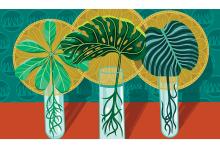seeds

BEFORE THE PANDEMIC hit, I could have told you the precise number of my indoor plants: zero. But then lockdown started and, like countless people around the world, I became obsessed with all things leafy and green. Once I learned how to keep a plant alive, I began to nurture cuttings. To see that first fresh leaf grow — an assurance that new roots had taken hold — filled me with a kind of joy heretofore unknown.
I needed to feel like life could not just survive, but flourish and thrive. “Give this at least six weeks before repotting,” I would text a friend from her porch as I dropped off the gift of a budding leafy monstera, “just to let the roots settle.” Then I’d trudge back to the sidewalk to watch my friend open her door, wave to me, and take this small extension of myself into her home. Months later, when we could visit in person, I’d get to see how much these little ones had grown. Great leafy extensions of love.
Most of the gospel readings this month contain horticultural parables — seeds and soil, wheat and weeds, sowers and reapers. Before the COVID-19 years, I had never read these parables through the eyes of someone who had nurtured plants to life. Their images had been abstractions, ideas, metaphors with no roots. But now that those seeds have grown, I see each one anew. Perhaps you do too?

In the dark days of Advent, we wonder when the birth pangs will end: Will light break into the darkest corners of our hearts, our families, our lives? Will God—can God—take the twisted sinew of our warped world and redeem it? Will we—can we—hold on through the night? Can we trust that light to come? These are the questions of Advent.
As we enter the season of Epiphany, new questions arise: Will we allow the light that has broken forth to illuminate the darkest corners of hearts, our families, and our lives? Can we—will we—follow Jesus as he untwists the mangled metal of our shattered souls ... and redeems it? Can we—will we—trust the light or will we hide from it? These are the questions of Epiphany.
The light of Epiphany illuminates in two directions: It flashes inward, revealing our twisted and fragmented souls, and it flashes outward, revealing the carnage and consequences of the lies our world has embraced and used to craft public policy, the lies we have believed and reinforced through our complicit acceptance, and the truth we must speak.
As we enter 2013, we look back and see that over the past four years much public good was done. Remember: The Lilly Ledbetter Fair Pay Act made it easier for women to fight pay discrimination. Remember the drama when Congress passed the Affordable Care Act and the Supreme Court upheld it, creating a path for tens of millions of Americans to finally receive health care. Remember the image of the last troops leaving Iraq.

Author’s Note: When Arizona House Bill 2281 was used to dismantle the Mexican American Studies program in Tucson public high schools earlier this year, books used in the courses were removed from classrooms—in at least one school as students watched. Most of the titles, but not all, were by Latino writers.
Instead of swallowing their dismay, several students documented what they witnessed through social media. That’s how members of the Houston-based writers’ collective Nuestra Palabra: Latino Writers Having Their Say heard about what happened in Tucson. Incensed by the stifling of knowledge, they organized the Librotraficante (literally, “book traffickers”) book caravan. Their goal was to “smuggle” the “contraband” books back into Tucson, and bring attention to what critics contend is a troubling combination of anti-intellectualism and the state’s anti-immigration stance enacted earlier.
Nuestra Palabra members worked with partner organizations along the caravan route to hold press conferences and celebrate Latino arts and culture at several Librotraficante book bashes. In addition to the public events, the five-day journey stopped in six cities, seeding Librotraficante underground libraries along the way. This is a reflection on riding the Librotraficante caravan, which took place in mid-March.
SEEDS. My parents were farm laborers for part of their young adult lives. They did that body-leeching work in the hot Texas sun, picking and hauling cantaloupe, watermelon, onions, and anything else that required a human hand.
My life has been very different from theirs. I make a living working at a desk. But I keep an image near my computer: It’s a black-and-white photo of farm laborers working a field. Bent at the waist, their arms hang from their torsos, grazing the ground like roots recently pulled from the earth. Whenever I start whining—about how hard my chair is, or that my computer is too slow, or that my agent doesn’t love me as much as his other clients—I look at this photo. I work, but the kind of work shown in the photo is grinding and thankless.
Because the workers’ faces are hidden in the shadow of broad-brimmed hats, I feel that I know even less about them. I don’t know their story. What I do know is that the spinach, tomatoes, and onions I enjoy on a chilled plate are because of these faceless, distant people. And yet, I know I’m not that far removed from them. Besides our shared heritage, it’s hard not to feel a sort of kinship to someone who makes it possible for food to appear on your plate.